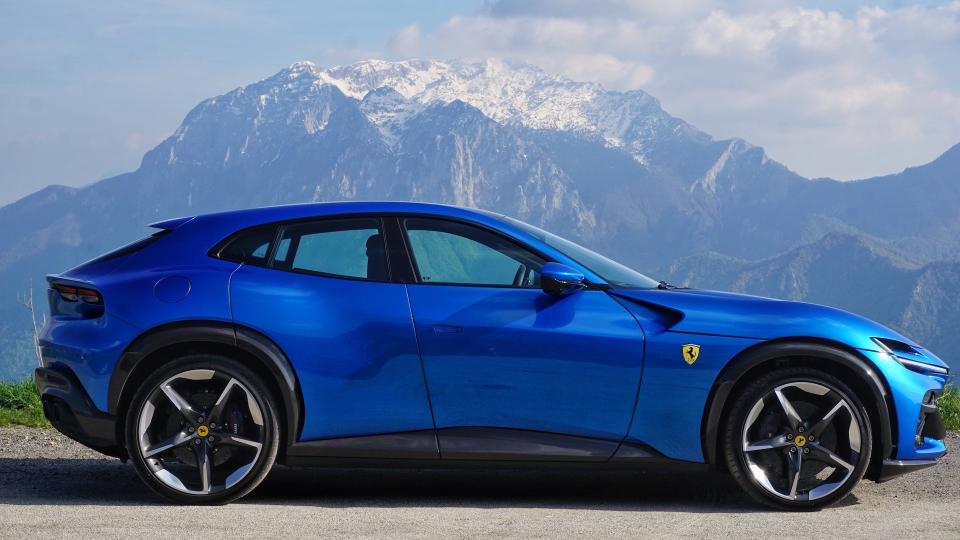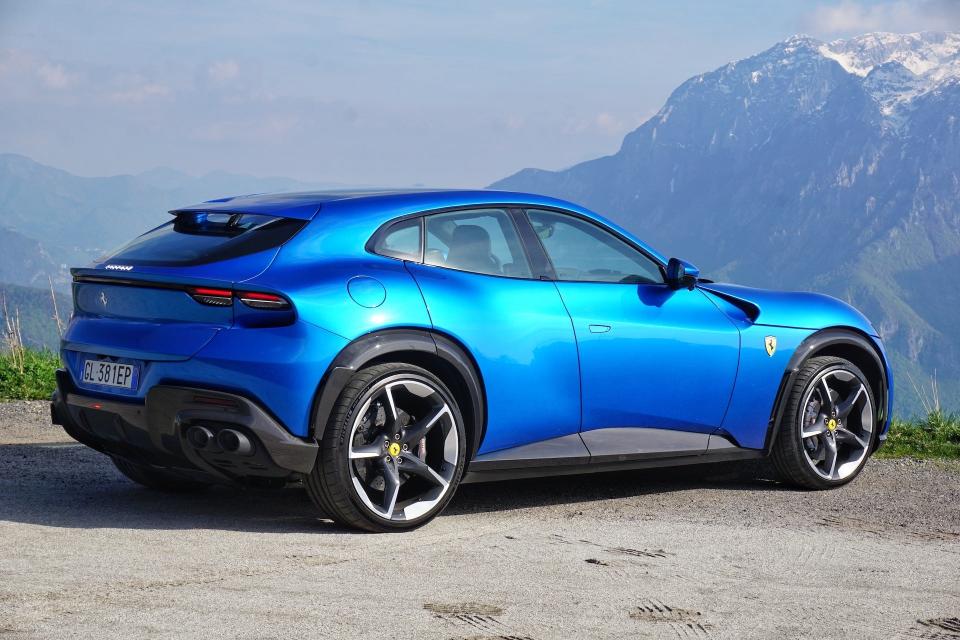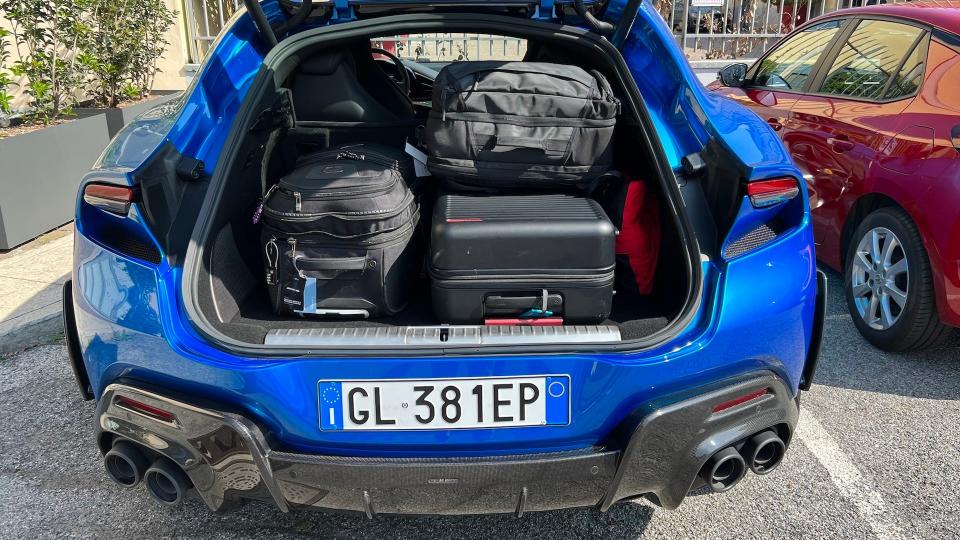2024 Ferrari Purosangue Review: A Worthy Supercar, Now in Family Size

Let’s skip over the part where you can’t believe Maranello actually built an SUV, crossover, “lifted utility vehicle,” whatever the hell you want to call it. Spending one second decrying this decision is genuinely one second too long. The 2024 Ferrari Purosangue is here in all of its 12-cylinder, four-door, four-seat, all-wheel-drive glory, and it doesn’t care what you think. Why? Because, first and foremost, it has a Cavallino Rampante on the hood, and because every single production slot is sold out until 2026. That’s why.
It’s not often that I—or any other automotive journalist, for that matter—get to test a truly first-of-a-kind vehicle. I’m not referring to a brand-new model or the reincarnation of a long-gone nameplate. No, I’m talking about the very first of something. I’m talking about the first-ever Ferrari SUV—even if Ferrari refuses to call it that. (It prefers “first-ever four-door, four-seater car.”)


Even in a segment jam-packed with high-performance SUVs, the Purosangue is the only single-trim, bespoke model in existence. Forget about your Mercedes-AMGs, your BMW Ms, Porsche Cayennes, and yes, even your Lamborghini Uruses. The Purosangue shares a platform with no one, and it certainly doesn’t exist as a business case to up-badge an existing SUV. If anything, only the Aston Martin DBX comes close.
So, the Purosangue is special, expensive, and also sold out. But what’s it like? How does it stack against other admittedly-capable SUVs? And most importantly, is it a real Ferrari? That’s exactly what I set out to find out over the course of two days in the mountains of Northern Italy.
2024 Ferrari Purosangue Specs
Base price (as tested): $397,300 ($493,707)
Powertrain: 6.5-liter naturally aspirated V12 | 8-speed dual-clutch automatic | all-wheel drive
Horsepower: 715 @ 7,750 rpm
Torque: 528 lb-ft @ 6,250 rpm
Seating capacity: 4
Curb weight: 4,481 pounds (dry)
EPA estimated fuel economy: TBA
Quick take: Some say Ferrari has sold its soul to the devil. I say, lucky devil.
Score: 9.5/10




The Basics
First, the name. Ferrari shuts down any blasphemous talk with a name that punches straight and punches hard: Purosangue. Puro, meaning pure, and sangue, meaning blood. Pureblood or thoroughbred—however you translate it—means one thing: it is as much a Ferrari as any other model that rolls out of Maranello. As to how to properly pronounce the name; you can listen to this accurate example. Puttosangweh.
The styling of the Purosangue has been controversial from the beginning, and it was made even more so after memes comparing it to a Mazda and a Prius made the rounds on social media. Blasphemy. What you can’t appreciate in photographs is just how refined the body really is, how curvy.




The low-sitting front end allows the massive V12 to breathe, but more specifically, it directs airflow in a number of ways and for multiple purposes. The air intakes around the DRLs guide air through the top of the tires, while the “floating” fender walls and flares serve as exhaust to excess air that might otherwise generate lift. The grille feeds air to the V12 so it can sing its song all the way up to 8,250 rpm while the smaller lateral intakes help with wake management by channeling air around the wheels. Then there’s the hood, which is a massive, sculpted piece of cold-stamped aluminum. Seriously, it’s hard to understand how enormous the hood (hinged at the front, of course) is until it’s fully open before you. I’m six feet tall and it towered over me by another foot, if not more. The hood itself has two air inlets that carry over onto the side of the car à la F12—Ferrari actually calls this an “aerobridge.”
According to engineers, it was the overall curvature of the car that presented the biggest aerodynamic challenge, which is why they kept the roof low and the tailgate angle as flush as possible with the rest of the car. Look closely and the angle of the rear window is drastically different than that of the windshield, giving the Purosangue a coupe, fastback-like profile. The rear windshield doesn’t even have a wiper, as engineers claim it doesn’t need one thanks to such ideal airflow over the roof.



As is the case with all Ferraris, the engine is the heart of the Purosangue. Derived from the hardcore 812 Competizione, this 6.5-liter V12 packs F1-derived engine mapping and a mix of new and revised internals that shape its character. A redesigned intake manifold is tasked with increasing torque and works in combination with the also-redesigned camshaft to offer a linear power curve (one less peaky than in the 812). The intake system is also revised, as well as the exhaust and injection systems. And while maximum power is always the goal, some components were also tuned for efficiency, too. For example, the geometry of the crankshaft, connecting rods, and pistons was modified to improve fuel consumption. Even the lubrication of these components was tweaked in order to increase efficiency and improve reliability.



The eight-speed transmission has been fully redesigned for the Purosangue, featuring a wet dual-clutch and dry sump architecture. This translates into a smaller and lighter unit compared to the seven-speed used in other models, while also improving shift times by 30%.
Driving the Ferrari Purosangue
Open the door and step inside the Purosangue. Did you feel that? You just stepped in—no circus act, no special procedure. Most noticeably, no barely squeezing in if you’re a big guy like me. Just throw a leg over and take a seat. The door opening is wide and generous, and while it still sits a lot lower than your average vehicle, it’s an easy ingress. Ferrari didn’t disclose how many ways the front seats are power-adjustable, but it’s a lot—and one of my favorite parts of the car, for sure. Remember, a good driving experience begins with a really good driving position. The bolstering, the firmness, and the angle of every section of the seat can be adjusted. You can, in fact, spend 10 hours sitting in one. And when you start to feel tired, turn on the massage function—a Ferrari first—and buckle up for another 10. That’s not something I can say about my experience in the F8 Tributo, or perhaps even the Roma.





Firing up the engine happens via a touch surface on the bottom of the steering wheel that lights up red when you step on the brake. It’s not an actual button and it feels rather sterile given the honorable task it performs, but it does have a modern look to it. Do the deed and hear the V12 come to life. The engine’s naturally aspirated nature means everything comes full blast much to the enjoyment of your ears—and perhaps the annoyance of those around you. You can’t fly incognito in one of these. And then there’s the sound—there’s no mistaking it for anything else. You can hear the exhaust tone modulate as the engine warms up and you can also feel it in the seat as the vibrations fluctuate. It’s these little details that no EV software can ever replicate.
https://www.youtube.com/shorts/TTTTBEaI3r8
Setting off, the first big takeaway had to do with the steering feel: it's light and quick. Other super-SUVs have quick reflexes too, but they typically all feel very heavy, especially the Aston. The Purosangue felt agile even when traveling at a chill pace. The suspension, too, felt remarkably civilized. I spent an hour fighting Milan traffic trying to escape the city, which also meant enduring thousand-year-old roads filled with potholes.
The big V12 can be as docile or as brutal as you want it to be, and after what seemed like an eternity, I was finally out of the city and on proper mountain roads above Lago di Como, where snow-capped peaks separate Italy from Switzerland. So, I chose brutality. I flicked the manettino into Sport mode and pushed the red selector down once to choose Hard suspension. I dug my right foot in and asked the Purosangue to give me my first taste of what it can do. Mamma mia.

The Purosangue lurched forward like a lioness hunting down its next meal. Zero hesitation, 100% laser focus. The sound of the V12, which up until that point had been present but mostly in the background, came roaring into the cabin as if it were saying, “Did you summon me? I’m here now.” The shift lights integrated into the top of the steering wheel quickly started lighting up, telling me it was time to shift into third gear as they flashed blue. I pulled on the right paddle, triggering a loud bang from the exhaust while a surge of power and torque continued to relentlessly thrust the 4,500-pound SUV forward.
Given the type of road I was on, second, third, and fourth gears kept the Purosangue right in the sweet spot to have a good ‘ol time. Some hairpins forced me to momentarily venture into first gear before giving it the full rigatoni and rocketing—literally, due to the thunderous sound—out of corners and into the distance. I’d like to believe that all the nonnas living in those sleepy Italian villages were okay with all the ruckus because I was driving a Ferrari, but I could be wrong.


I may not have been able to explore its top speed, but those tight mountain roads provided endless opportunities to feel the Purosangue’s extremely advanced, extremely complex active suspension. See, most high-performance cars have very similar suspension systems tuned in a variety of ways, but the Purosangue isn’t most high-performance cars. For starters, Ferrari ditched anti-roll bars entirely. In their place are four MultiMatic TrueActive Spool Valve dampers that rely on liquid-cooled, 48-volt electric motors to send force to each damper. Specifically, up to 1,120 pounds in a matter of milliseconds and as often as the computer thinks is necessary, which Ferrari claims can be every 0.05 seconds.
This does a couple of cool things. First, it can stabilize each wheel independently based on its own dynamics, but it can also pull the body toward the wheel in order to keep the body as stable as possible during hard cornering. Secondly, it lets the dampers react quickly to suspension events and sort them out before they reach the cabin, which is why I didn’t actually feel any of those potholes when driving through the city. Lastly, the Purosangue’s trick suspension can also distribute load balance by as much as 10%, which explains why heavy braking was met with little to no weight shift, as the dampers quickly adjusted front-to-rear load on the fly.
As a result, the Purosangue proved to be tossable in a way that most Ferraris aren’t. Its combination of GT and supercar dynamics allowed it to have fun in the most surprising ways. Several hairpins on my route had lots of debris at the apex, forcing me to take a wider line to avoid it. This would normally upset a supercar’s balance and make it understeer/oversteer upon entry/exit, forcing the driver to fight the car’s tendencies. In the Purosangue, the suspension canceled out any forward weight transfer upon hard braking while the dampers kept body roll to a minimum and helped the all-wheel drive apply traction as necessary. I waltzed through just as if I had taken the perfect driving line. Four-wheel steering also played a huge role in these tight corners, further making the 16-foot-long SUV corner sharper than a Miata.


Rally-esque switchbacks atop morphed into sweeping country roads flowing in and out of luscious green valleys down below. I kept the manettino in Sport but clicked down to Soft suspension mode to give myself a little break. The transformation in ride quality is drastic and immediate. The dampers quickly get to work muting all imperfections, even if just seconds ago they were transmitting every single characteristic of the tarmac up to the steering wheel. I enjoyed a different feel of the Purosangue by exploring higher cruising speeds while still doing plenty of wheeling. This is where I really started to feel the soul of the Purosangue. It had just bombed up and down incredibly twisty roads and now it was gobbling up kilometers in a speedy yet tranquil manner. The sun was beginning to set and all the dashboard instrumentation began to come alive; the gauges, the few buttons, the mood lighting, the fantastic headlights. It was a nice way to end the day. Back on Comfort and Soft suspension modes and with the transmission set to fully automatic, I cruised back into town to rest up for the night.
But first, I had to venture into an underground parking lot with steep ramp access and make my way through tight rows of cars—the combined value of which probably didn’t even add up to the starting price of the Purosangue. The experience was easy breezy and nowhere nearly as nerve-wracking as it would’ve been in other Ferraris. While the entry was pretty steep (and I was cautioned by the front desk staff that most Ferraris don’t make it there), the nose lift system in the Purosangue came in clutch and took all the drama out of the situation. Then, the surround-view cameras kept an eye out as I made my way through the garage on the lookout for a safe corner spot. Suddenly—bingo, another Ferrari! A 458 (whose owner clearly went against the front desk staff’s advice) with an empty spot next to it. Parking was painless. The Purosangue was easy to maneuver, visibility was great, and the technology (cameras and sensors) worked perfectly. I pulled both paddles to shift into neutral, made sure the auto parking brake was engaged, and wished the ‘Rari along with its new friend a good night.



A More Usable Ferrari
I’ll start with this: the backseats of the Purosangue are more than big enough for large adults. They’re quite comfortable and can be reclined, slid forward and backward, and are heated and cooled. Legroom is plentiful even when the front passengers are relatively tall. However, I stuffed my assistant (my dad) in the back for most of my second day with the car, and he reported no issues. In fact, he actually fell asleep at one point, which has to be some sort of compliment to the people who designed the rear of the cabin. He also enjoyed the clever way in which you operate the rear doors—which, by the way, are rear-hinged and open coach-style. From the outside, give a one-finger pull on the hidden tab at the bottom of the B-pillar to make it prop open, then continue opening the door yourself. However, pull and hold the same tab for two seconds and the door will fully open all the way on its own à la Rolls-Royce Cullinan (which is the only other SUV in the world to have a V12). Once inside, simply push a button on the B-pillar and let the door close on its own.




The Purosangue’s tech is fairly unconventional but a triumph nonetheless. Ferrari has eschewed a center touchscreen for two 10.2-inch screens placed in front of both front occupants. The one in front of the passenger is touch-sensitive, of course, and lets them take on DJ duty, among other things. With my dad riding shotgun, this meant lots of Santana and Barry White. A rotary dial with a small touchscreen takes care of HVAC and all of the seat-related controls and works rather well while looking quite handsome. Steering wheel controls are fairly simple, too, and add up to a cabin that’s thoroughly easy to use.
Value and Verdict
A key moment of my test came right at the end of it when it was time to return the car and head back home. I dutifully gathered our suitcases and loaded them into the trunk. It may look basic, but there’s actually plenty of capability built into the cargo space of the Purosangue. You can recline the rear seats forward to make a huge cargo area with a flat floor, you can keep the top cover to hide your belongings from prying eyes, or you can use it as a separator to keep things from moving around within the trunk. Also, you can remove it in order to stack stuff higher than the cover height, which is what I did. Even with the rear seats upright, you could easily fit a couple of golf bags or whatever else you’re into. Lower one of the rear seats and you’ve got plenty of room for skis, wakeboards, etc. This is the utility Ferrari, the one you buy when you actually want to spend time with your family, go places, and see the world.

As a car enthusiast, husband, and dad of kids and dogs, this really spoke to me. Supercars are fun and I truly love them, but you also get to a stage in life where you want to share these cool experiences with your loved ones. The Purosangue allows you to do that. It’s a thoroughbred supercar, but one that allows you to share driving joy with others. Ironically, I wouldn’t have been able to spend a couple of days with my dad had it not been for the Purosangue’s trunk.
From a pure performance perspective, it subdues every high-po SUV currently on the market. Not just that, but it does so with more style and class than the longest players in this game can offer. Whether you’re picking up kids from school or a couple of, er, companions for a lap around Europe, the Purosangue can help you do that without watering down the true Ferrari experience.
If you’ve got the money—and the need/want to take a couple more folks on your escapades—you’d be silly to not buy one of these.

Email the author at jerry@thedrive.com

 Yahoo Autos
Yahoo Autos 